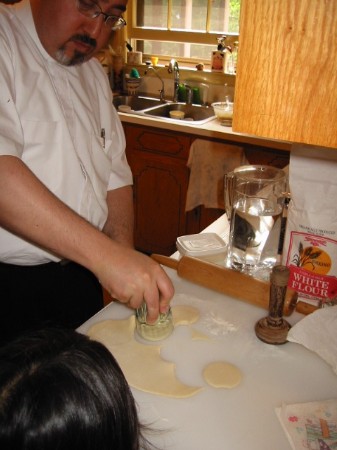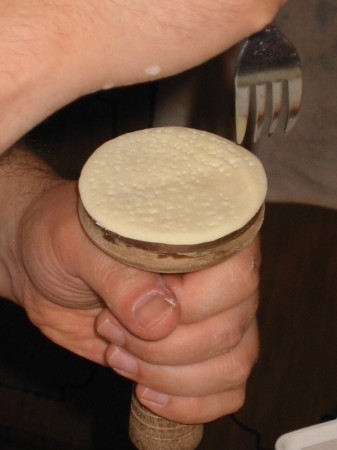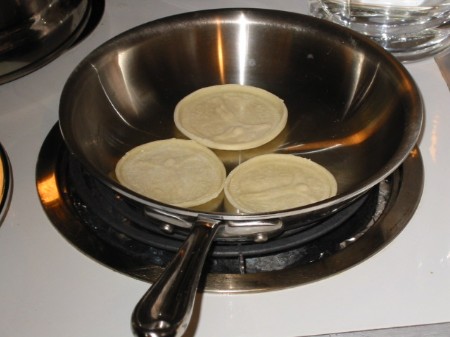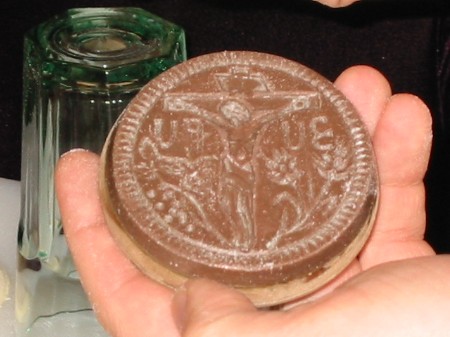Return
to Main Page
Armenian
Nshkhar
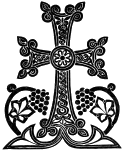
By Father Simeon Odabashian, New
York Diocese of the Armenian Church of America, His Eminence Archbishop, Khajag
Barsamian,
Primate.
Pictures from http://www.telf.com/church/Pictures/848.html.
The Making of the Communion Bread or
Nuskhar
According to
the tradition of the Armenian Church the Communion bread (host or wafer) called
Nushkhar is made with flour and water only. Typically the celebrant of
the Divine Liturgy prepares the nushkhar, usually six in number, either
the day before or on the day of the liturgy. The nushkhar is a flat
wafer, whose diameter is about 2.5
inches.
The
preparer of the bread begins by saying the Lord's prayer and during the process
recites psalms. He mixes a sufficient amount of flour and water to create a
simple dough ball, which is allowed to rest for a few minutes with a glass over
it to prevent
drying.
Then
the priest rolls out the dough to an approximately 1/8 inch thickness. With a
cookie cutter or glass having the same diameter as the nushkhar stamp he
cuts out as many circles as possible. The remaining dough is made into a ball
and is again placed under a glass (to be rolled out again for additional
wafers).
He
then takes each circle of dough and affixes it to the stamp and applies equal
pressure to insure that the imprint will be clear and even. Prior to this a
small amount of flour may be sprinkled on the dough to prevent it from sticking
to the
stamp.
While
the dough is still on the stamp, he pierces the entire back of the dough with a
fork. This act has two purposes: Symbolically we remember the sufferings of our
Lord Jesus Christ and practically piercing the dough prevents the formation of
bubbles during the cooking
process.
The
nushkhars may be cooked (always print side up) either on a tray in a
pre-heated oven or on a preheated frying pan on the stove. In either case they
are cooked with low heat and at the slightest sign of browning they are ready.
Cooked nushkhars may be wrapped in aluminum foil to preserve freshness.
Some prefer to make a larger number for distribution on feast days in which case
it is permissible to freeze the
supply.
The
nushkhar stamp is usually carved out of wood although recently
attempts at making the stamps out of synthetic materials have been made
successfully. The stamp is carved with the crucifixion, with grains of wheat and
bunches of grapes, as well as the Armenian initials of Jesus Christ (JS CT). It
is customary to distribute unconsecrated nushhars to the faithful on
Theophany and Easter in which cases they may be made with special stamps carved
with the nativity or resurrection
scene.
At
the beginning of the Divine Liturgy the deacon presents the nushkhars on
a tray to the celebrant who chooses the most perfect one for consecration. If a
larger number of communicants is anticipated, he may use more than one.
Finally,
when a priest is called to bless a home he presents the family with an
unconsecrated nushkhar, which is kept in the house as a sign of the
blessing. Often it is placed in a rice or flour jar. It is also customary for
the priest to place a nushkhar on the chest of the deceased at the time
of the wake service.
Many thanks to Fr. Simeon for this article.
from another website...

"Mass" Antidoron is a very
thin bread and
is
"Nushkhar" is a wafer prepared by the priest
in
"Matrix" is a round template with carvings
placed on the Holy Altar and
blessed by
the
a solemn way and is used for the Divine
Liturgy.
generally of Jesus Christ or other symbols
priest. It is distributed to the
faithful who
have
It has the stamp of the cross, the lamb or
other
and is used to stamp the "Nushkhar".
not taken Holy Communion that
day.
symbols.


